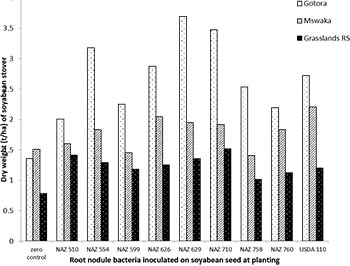Soyabean is an important crop in the agriculture-led economy of Zimbabwe and production is supported by inoculation with rhizobia. Rhizobia are soil bacteria that have the ability to form symbioses with legumes and fix nitrogen within novel structures called nodules. This obviates the need for nitrogen fertilizer, which is expensive and difficult to manage. While rhizobia are found in many soils, any given population must be screened in order to select individual isolates with superior nitrogen fixation abilities and other desirable traits. An elite rhizobia inoculant strain of Japanese origin, USDA 110, is used for inoculation of soyabean in Zimbabwe. However, it does not persist very well in farmers’ fields.
Indigenous rhizobia often have superior ability to survive under their native environments. Inoculation of elite exotic strains into soils that harbour indigenous rhizobia may result in new rhizobia that have the environmental adaptation of local rhizobia and the nitrogen fixation of elite inoculant strains, through horizontal gene transfer. The most significant output from my study would be a recommendation of such rhizobia inoculant strains to replace the elite USDA 110 in order to sustainably increase the yield of inoculated soyabean in Zimbabwe.
In 2011/12 agriculture season, I isolated soyabean RNB from fields that had been inoculated with USDA 110 at least five years prior. To answer the question of diversity and phylogeny of soyabean root nodule bacteria in Zimbabwe, I characterised one hundred and thirty-seven (137) isolates in the laboratory. Only eighteen belong to the same species as inoculant strain USDA 110. The remaining eighty seven percent (87 %) belong to a combination of three species. We conclude that there are at least three species of soyabean RNB that are indigenous to Zimbabwe, and that five years after inoculation, indigenous populations outnumber those of inoculant strains.
| I evaluated the same isolates for nitrogen fixation under glasshouse conditions. The isolates range from poor fixers to isolates that outperform USDA 110. I identified the top 10 % nitrogen fixers for further testing under field conditions and onward recommendation for use as inoculant strains. In the last agriculture season, which spanned October 2016 to March 2017, I set up three experiments to evaluate performance under field conditions. Each experiment consisted of eight test isolates from my study, a non-inoculated control and a positive control inoculated with the inoculant strain USDA 110. All treatments were replicated four times. Figure 1 below shows the dry weights of soyabean stover, evaluated before physiological maturity when the grain yield becomes available. The stover is correlated to nitrogen fixation and grain yield. |

|
The differences in stover recovered across the sites may be due to the variation of rainfall amounts received. Gotora site had the highest biomass accumulation; followed by Muswaka and GRS had the least biomass accumulation. Preliminary results of stover accumulation in plots inoculated with isolates NAZ 629, NAZ 710, NAZ 626 and NAZ 554 exceeded the biomass from plots inoculated with USDA 110 and suggest that these isolates can be recommended for rhizobia inoculation.
Mazvita Chiduwa, Murdoch Univeristy (Click here for her 2016 update)
